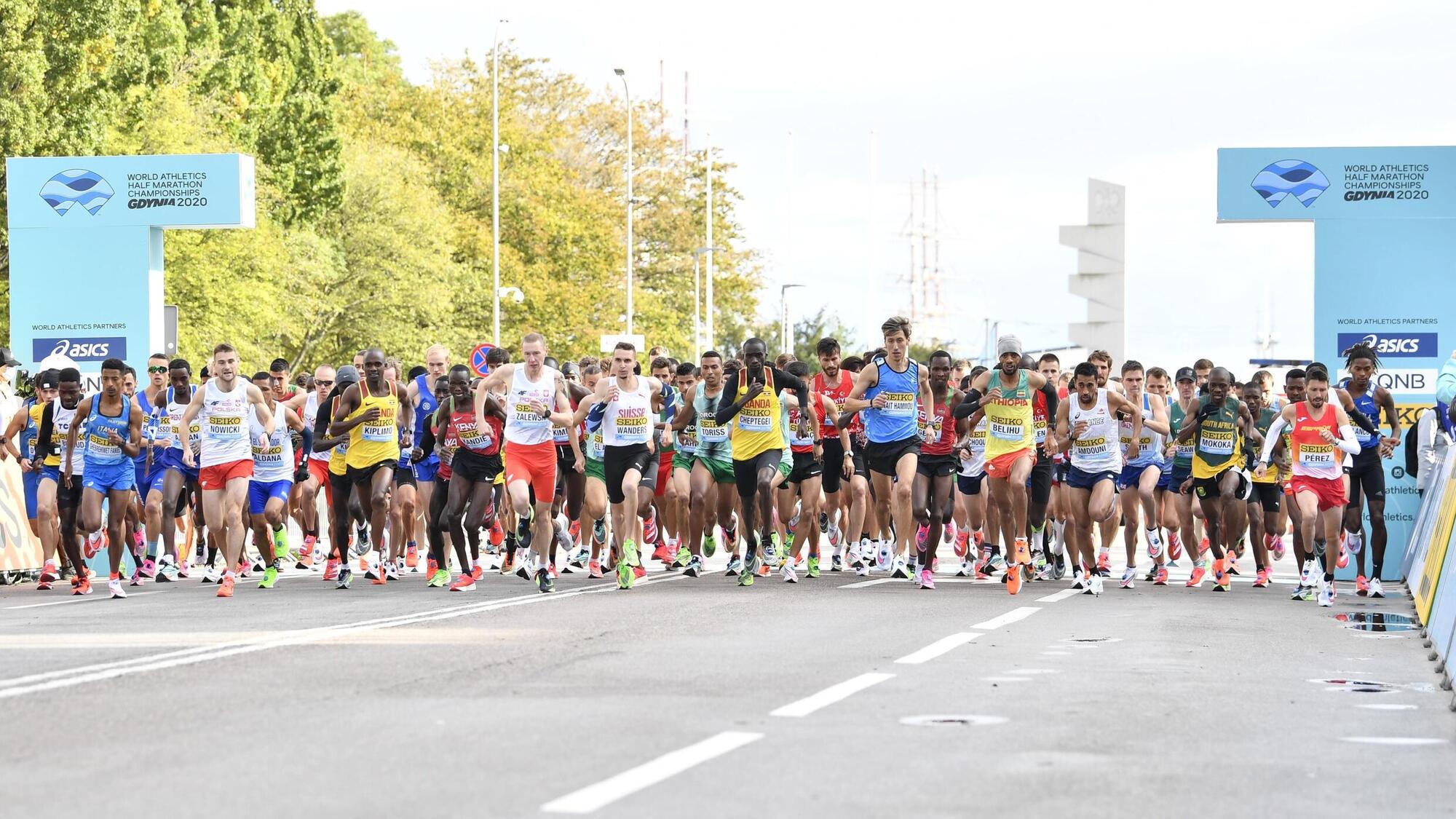Home>Misc>Featured>How To Train For A Marathon For Beginners


Featured
How To Train For A Marathon For Beginners
Modified: August 21, 2023
Learn the best tips and tricks for beginners on how to train for a marathon. Discover featured workouts and expert advice to help you succeed in your marathon training journey.
Introduction
Running a marathon is an incredible and rewarding challenge that requires careful preparation and training. Whether you’re a seasoned runner looking to step up your distance or a complete beginner eager to tackle your first marathon, this article is here to guide you through the process.
Training for a marathon can be a physically and mentally demanding task, but with the right approach and mindset, it is absolutely achievable. In this comprehensive guide, we will cover all the essential aspects of marathon training for beginners. From choosing the right training plan to injury prevention strategies, we’ll provide you with the knowledge and tools you need to successfully complete your marathon journey.
Running a marathon is not just about the race day itself; it’s a journey that starts months in advance. It requires commitment, consistency, and a gradual build-up of strength and endurance. While it may seem intimidating at first, remember that every marathon runner started with their first step, and with proper training, you too can cross that finish line with a sense of accomplishment and pride.
Throughout this guide, we will explore different topics such as setting goals, selecting the right gear and equipment, honing your nutrition and hydration strategies, building endurance, incorporating speedwork, cross-training, rest and recovery, injury prevention, mental preparation, and race day strategies. Each of these topics plays a crucial role in preparing your mind and body for the marathon challenge ahead.
Before we delve into the specifics of marathon training, it’s important to remember to consult with a healthcare professional before starting any new exercise program, especially if you have any pre-existing health conditions or injuries. They will be able to provide you with personalized advice and ensure that you approach your marathon training safely and effectively.
Now that we’ve laid the groundwork, let’s begin the exciting journey of training for a marathon. Get ready to push your limits, discover new strengths, and embrace the transformative experience that awaits you on the road to becoming a marathon runner.
Choosing the Right Training Plan
When it comes to marathon training, having a well-structured and appropriate training plan is crucial. A good training plan will provide you with the guidance and structure needed to gradually increase your mileage, build endurance, and prepare your body for the demands of a marathon.
There are various training plans available, each catering to different levels of experience and goals. As a beginner, it’s important to choose a training plan specifically designed for novice marathon runners. These plans typically have a longer duration, allowing for a slower and more gradual increase in mileage to prevent injuries and overexertion.
When selecting a training plan, consider your current fitness level, running experience, and available time commitment. If you’re new to running or have been inactive for a while, choosing a beginner-friendly plan that incorporates walk/run intervals can help you ease into a running routine without putting excessive strain on your body.
Another factor to consider is the number of training days per week. Most training plans for beginners include 3-4 running days per week, with rest days in between to allow for recovery. This balance is important to prevent overtraining and minimize the risk of injuries.
It’s important to note that training plans are not one-size-fits-all, and it’s perfectly fine to make adjustments based on your individual needs and preferences. However, it’s crucial to maintain the overall structure and progression of the plan.
In addition to the running schedule, look for a training plan that incorporates cross-training and strength training exercises. Cross-training activities such as cycling, swimming, or yoga can help improve overall fitness, prevent muscle imbalances, and give your body a break from the repetitive impact of running.
Seeking guidance from experienced runners, coaches, or online resources can be immensely helpful in choosing the right training plan. Consider joining a local running club or online running community where you can connect with other marathon runners and gain valuable insights and support.
Remember, the key to successful marathon training is consistency and gradual progression. Be patient with yourself, listen to your body, and make adjustments as needed. With the right training plan tailored to your needs, you’ll be well on your way to crossing that marathon finish line.
Setting Goals
Setting clear and achievable goals is an essential step in your marathon training journey. Goals provide a sense of direction and purpose, keeping you motivated and focused throughout the training process.
When setting goals for your marathon, it’s important to consider both outcome goals and process goals. Outcome goals focus on the end result, such as finishing the marathon within a specific time or achieving a personal best. Process goals, on the other hand, concentrate on the actions and behaviors that will lead to the desired outcome.
Begin by assessing your current fitness level and understanding your strengths and limitations. Be realistic and set goals that are challenging yet attainable. Starting with smaller milestones can help build confidence and momentum along the way.
Consider setting both short-term and long-term goals. Short-term goals can be weekly or monthly targets, such as completing a specific number of training runs or increasing your mileage gradually. Long-term goals, like finishing your first marathon or improving your finish time in subsequent races, provide a broader focus for your overall training plan.
It’s also important to establish process goals that are within your control. These can include incorporating strength training exercises into your routine, sticking to your training schedule, or practicing proper nutrition and hydration strategies. Focusing on these process goals will help you develop the necessary habits and behaviors to support your marathon training journey.
Remember that goals should be measurable and time-bound. Instead of aiming to “run faster,” set a specific time goal that you want to achieve. This will help you track your progress and make necessary adjustments to your training plan along the way.
Writing your goals down and displaying them in a visible place can serve as a constant reminder of what you’re working towards. Share your goals with supportive family members, friends, or fellow runners who can provide encouragement and accountability throughout your training.
Lastly, be flexible with your goals. Recognize that there may be unforeseen circumstances or setbacks along the way, and adjust as necessary. Remember that the journey to a marathon is as important as the destination, and the experience itself will provide valuable learnings and personal growth.
By setting clear, realistic goals and committing to the process, you’ll be well on your way to achieving success in your marathon training and crossing that finish line with a sense of accomplishment.
Gear and Equipment
Choosing the right gear and equipment is essential for marathon training and ensuring a comfortable and enjoyable running experience. Here are the key items to consider:
- Running Shoes: Invest in a good pair of running shoes that provide proper cushioning, support, and fit your foot shape. Visit a specialty running store to get fitted by experts who can assess your running gait and recommend the most suitable shoes.
- Moisture-Wicking Clothing: Opt for moisture-wicking fabrics that help keep you dry and comfortable during long training runs. Avoid cotton, as it tends to retain moisture and can lead to chafing and discomfort.
- Appropriate Socks: Choose socks specifically designed for running, made from moisture-wicking materials. Look for seamless construction and a snug fit to avoid blisters and rubbing.
- GPS Watch or Running App: Consider investing in a GPS watch or using a running app on your smartphone to track distance, pace, and other essential metrics. This can help you monitor your progress and stay on track with your training plan.
- Hydration System: Stay adequately hydrated during long runs with a handheld water bottle, hydration belt, or a hydration backpack. Choose a system that allows for convenient access to fluids without disrupting your running stride.
- Running Accessories: Depending on your preferences and needs, consider additional accessories such as a running belt for storing essentials like keys and small items, a hat or visor to protect against the sun, and sunglasses for eye protection.
- Reflective Gear and Lights: If you’ll be running in low-light conditions or early mornings or evenings, wear reflective clothing and accessories to enhance visibility. Additionally, attach a small LED light to your clothing or gear for added safety.
- Compression Gear: Compression socks, sleeves, or tights can aid in muscle recovery and reduce muscle fatigue during long runs. They can also provide additional support for the calves and shins.
It’s important to test and break in your gear before race day to ensure everything fits comfortably and works well for you. Avoid making any significant changes to your gear or clothing on race day to minimize the risk of discomfort or chafing.
Remember that investing in proper gear and equipment can significantly impact your performance, comfort, and overall running experience. Take the time to find what works best for you and make adjustments as needed along your marathon training journey.
Nutrition and Hydration
Nutrition and hydration play a crucial role in your marathon training and performance. Proper fueling and hydration will help optimize your energy levels, enhance your endurance, and aid in muscle recovery. Here are some key considerations:
- Macronutrients: Ensure you’re consuming a well-balanced diet that includes carbohydrates, proteins, and healthy fats. Carbohydrates are the primary fuel source for endurance running, so focus on whole grains, fruits, and vegetables. Include lean proteins for muscle repair and recovery, and incorporate healthy fats from sources like nuts, avocados, and olive oil.
- Pre-Run Fueling: Eat a small meal or snack that includes easily digestible carbohydrates and a small amount of protein about 1-2 hours before your long runs. This will provide you with the necessary energy to sustain your run without causing digestive discomfort.
- Hydration: Stay well-hydrated throughout the day, and ensure you’re drinking enough fluids during your training runs. Aim to consume about 8-10 ounces of water every 20 minutes during exercise, and consider electrolyte replacement options for longer runs to replenish key minerals lost through sweat.
- During-Run Fueling: For runs lasting longer than 90 minutes, consider fueling with easily digestible carbohydrates in the form of energy gels, chews, or sports drinks. Experiment during training to find what works best for you and practice fueling strategies that you plan to use on race day.
- Post-Run Recovery: Consuming a combination of carbohydrates and protein within 30-60 minutes after your run helps replenish glycogen stores and promotes muscle repair. Options include a recovery drink, a balanced meal, or a snack that combines carbohydrates and protein.
- Listen to Your Body: Everyone’s nutritional needs are different, so pay attention to how your body responds to different foods and hydration strategies. Keep a food and hydration journal to observe patterns and make adjustments accordingly.
- Seek Professional Guidance: Consider consulting with a registered dietitian who specializes in sports nutrition to develop a personalized nutrition and hydration plan that caters to your specific needs and goals.
It’s important to note that nutrition and hydration strategies should be tested during training to determine what works best for you. Avoid trying new foods, drinks, or supplements on race day to minimize the risk of digestive issues or discomfort.
Remember, proper nutrition and hydration are essential not only for your training but also for your overall health and well-being. By fueling your body with the right nutrients and staying properly hydrated, you’ll optimize your performance and be better equipped to conquer the marathon distance.
Building Endurance
Building endurance is a fundamental aspect of marathon training. It involves gradually increasing your running distance and time to improve your cardiovascular fitness and stamina. Here are some effective strategies to build endurance:
- Follow a Progressive Training Plan: Choose a training plan that includes a gradual increase in mileage over time. This progressive approach allows your body to adapt and build endurance without overexertion or risk of injury.
- Long Slow Distance Runs: Incorporate weekly long runs into your training schedule. These runs should be at a slower, conversational pace to build aerobic endurance and teach your body to sustain longer durations of exercise.
- Run-Walk Method: If you’re just starting out or struggling with endurance, consider incorporating a run-walk method. Alternate between running and walking intervals to gradually build up your running stamina.
- Incorporate Fartlek Runs: Fartlek, meaning “speed play,” involves varying your pace throughout your run. Incorporate spurts of faster running followed by recovery periods at an easy pace. This technique helps improve your anaerobic threshold and teaches your body to sustain higher intensity efforts.
- Hill Training: Include hill workouts in your training plan to strengthen your lower body muscles and improve your resistance to fatigue. Hill running builds explosive power and increases your overall endurance.
- Tempo Runs: Tempo runs involve running at a challenging, but sustainable pace that is slightly faster than your comfortable pace. These runs improve your lactate threshold and enable you to sustain higher speeds for longer periods.
- Consistency: Regularity and consistency in your training are key to building endurance. Aim to run consistently throughout the week, slowly increasing your mileage over time. Remember that small, incremental improvements add up over the course of your training.
- Recovery Runs and Rest Days: Include easy-paced recovery runs after harder workouts to aid in muscle recovery and prevent overtraining. Rest days are equally important to allow your body to rest and adapt to the training stimulus.
- Listen to Your Body: Pay attention to any signs of fatigue or excessive soreness. Pushing yourself too hard without adequate rest and recovery can lead to injury and hinder your progress. Be mindful of your body’s response and adjust your training accordingly.
Building endurance takes time, patience, and dedication. It’s important to remain consistent with your training and gradually challenge yourself to push beyond your comfort zone. Remember to approach your training with a realistic mindset and understand that building endurance is a gradual process.
By incorporating these strategies into your training plan, you’ll steadily increase your endurance and be well-prepared for the distance and challenges of a marathon.
Incorporating Speedwork
Speedwork is an essential component of marathon training that helps improve your running speed, efficiency, and ability to sustain faster paces. Incorporating speedwork into your training plan can enhance your overall performance and make you a stronger and more well-rounded runner. Here are some key strategies for incorporating speedwork:
- Interval Training: Interval training involves alternating between periods of intense effort and active recovery. Run at a challenging pace (80-90% of your maximum effort) for a specific distance or time, followed by an easy-paced recovery period. Repeat this cycle for several sets.
- Track Workouts: Head to a local track or find a measured stretch of road to perform structured speedwork. Work on varying distances such as 400 meters, 800 meters, or mile repeats, focusing on maintaining a consistent and challenging pace.
- Tempo Runs: Tempo runs, also known as threshold runs, involve running at a comfortably hard pace for an extended distance. These workouts improve your lactate threshold, allowing you to sustain a faster pace for longer periods.
- Fartlek Training: Fartlek, meaning “speed play,” involves unstructured speed variation during a run. Incorporate bursts of faster running or pick up the pace whenever you feel comfortable, alternating with slower recovery segments. Fartlek runs can be performed on any terrain and provide flexibility for spontaneous speed intervals.
- Hill Repeats: Find a challenging hill and run uphill at a hard effort, then recover with an easy jog or walk downhill. Hill repeats build leg strength and power, improve running form, and increase your overall speed and endurance.
- Progressive Runs: Incorporate a progressive run into your training, where you gradually increase your pace throughout the run. Begin at an easy pace and gradually pick up the tempo, finishing with a strong effort. This type of run helps simulate the latter stages of a marathon when fatigue sets in.
- Rest and Recovery: Speedwork places significant stress on your muscles and body. It’s important to allow adequate rest and recovery time between speed sessions to avoid overtraining and reduce the risk of injury.
- Gradual Progression: Start with shorter intervals or slower paces and gradually increase the intensity and duration of your speedwork sessions over time. This allows your body to adapt and avoid overexertion.
It’s important to note that speedwork should be incorporated into your training gradually and balanced with easy and long runs to prevent burnout and minimize the risk of injury. Consider consulting with a running coach or experienced runner for guidance and personalized recommendations.
Remember, speedwork should be challenging but manageable. Listen to your body, pay attention to proper form and technique, and be consistent with your speed workouts. With time and dedicated effort, speedwork will improve your running efficiency and help you achieve your marathon goals.
Cross Training
Cross training is an important component of marathon training that involves incorporating different forms of exercise and activities into your routine. It not only helps prevent overuse injuries but also improves your overall fitness and enhances your running performance. Here are some key benefits and strategies for cross training:
- Injury Prevention: Engaging in activities other than running helps reduce the repetitive stress on your muscles and joints, lowering the risk of overuse injuries common in marathon training.
- Improved Cardiovascular Fitness: Cross training activities like cycling, swimming, or elliptical training provide excellent cardiovascular workouts, helping to increase your overall fitness and endurance.
- Strength and Stability: Incorporating strength training exercises into your cross training routine helps develop stronger muscles and improves stability, which can improve running form and reduce the risk of imbalances or compensations.
- Active Recovery: Cross training on rest days or easy days allows you to stay active without placing additional stress on your running muscles. It promotes recovery by increasing blood flow and aiding in the removal of lactic acid.
- Mental Break: Cross training provides a mental break from the repetitive nature of running. It allows you to pursue other activities, keep your workouts varied, and prevent burnout.
- Flexibility and Mobility: Incorporating activities like yoga or Pilates into your cross training routine can improve flexibility, mobility, and muscle balance, which contribute to better running mechanics.
- Choose Activities You Enjoy: Select cross training activities that you find enjoyable and can easily incorporate into your schedule. This will help maintain motivation and make your training more enjoyable.
- Balance and Periodization: Find a balance between running and cross training to ensure adequate recovery while still challenging your body. Periodize your training by adjusting the intensity and volume of cross training as you progress through different phases of your marathon training plan.
When cross training, aim for a mix of aerobic exercises, such as cycling or swimming, and exercises that focus on strength training and flexibility, such as weightlifting or Pilates. The specific activities should complement and support your running goals.
Be sure to listen to your body and avoid overdoing it with cross training. It should enhance your running performance, not detract from it. If you notice any excessive fatigue or increased risk of injury, adjust your cross training activities or consult with a coach or healthcare professional.
Remember, cross training should be seen as a supplement to your running, not a replacement. It should support your running goals and help you become a stronger, more well-rounded athlete throughout your marathon training journey.
Rest and Recovery
Rest and recovery are vital components of marathon training and essential for optimizing performance, preventing injuries, and allowing your body to adapt and grow stronger. It’s important to prioritize adequate rest and recovery throughout your training. Here’s why it matters and how to incorporate it into your routine:
- Muscle Repair and Growth: Rest days allow your muscles to recover and repair the micro-tears that occur during training. This process is crucial for building strength and endurance.
- Injury Prevention: Rest days help prevent overuse injuries by giving your body time to heal and recharge. Pushing yourself too hard without proper rest can lead to fatigue, decreased performance, and increased risk of injury.
- Replenish Energy Stores: Rest days provide an opportunity to refuel and replenish glycogen stores in the muscles, ensuring you have adequate energy for your next training session.
- Mental Well-being: Rest days contribute to mental well-being, reducing stress and preventing burnout. Use this time to relax, engage in hobbies, or spend time with loved ones.
- Active Recovery: On rest days, you can still engage in light and low-impact activities such as walking, gentle stretching, or yoga to promote blood circulation and aid in muscle recovery.
- Sleep: Prioritize quality sleep, as it is crucial for muscle repair, hormone regulation, and cognitive function. Aim for 7-9 hours of uninterrupted sleep per night.
- Listen to Your Body: Pay attention to your body’s signals for rest and recovery. If you’re feeling excessively fatigued, experiencing persistent muscle soreness, or noticing decreased motivation, it may be a sign that you need more rest.
- Periodize Your Training: Incorporate planned rest days and recovery weeks into your training plan. Every few weeks, reduce training volume or intensity to give your body a chance to fully recover and adapt to the training stimulus.
- Self-Care: Use rest days as an opportunity for self-care practices such as foam rolling, massage, hot baths, or gentle stretching to promote relaxation and recovery.
- Stay Consistent: Consistency is key, not only in training but also in rest and recovery. Incorporating regular rest days and prioritizing recovery will ensure that you can sustain your training without setbacks.
Remember, rest and recovery are as important as the training itself. Trust the process, be patient with your body, and give it the time and care it needs to adapt and grow stronger throughout your marathon training journey.
Injury Prevention
Injury prevention is a crucial aspect of marathon training to ensure you stay healthy, strong, and able to complete your training and race successfully. Incorporating the following strategies into your training plan will help minimize the risk of injuries:
- Gradual Progression: Avoid sudden increases in mileage or intensity. Gradually increase your mileage and training load over time to allow your body to adapt and reduce the risk of overuse injuries.
- Proper Warm-up and Cool-down: Always begin your runs with a dynamic warm-up routine to prepare your muscles and joints. Finish each run with a cool-down routine that includes stretching to promote flexibility and minimize post-run muscle tightness.
- Strength Training: Incorporate strength training exercises into your routine to build muscular strength and stability. Focus on exercises that target the major muscle groups used in running, including the core, hips, glutes, and legs.
- Flexibility and Mobility: Perform regular stretching and mobility exercises to improve your range of motion and prevent muscle imbalances. Include dynamic stretches before your runs and static stretches after your runs.
- Proper Footwear: Invest in a pair of shoes specifically designed for running and ensure they provide proper support and cushioning. Replace your shoes every 300-500 miles or when they show signs of wear to maintain optimal shock absorption and injury prevention.
- Listen to Your Body: Pay attention to any signs of pain, discomfort, or unusual fatigue. If you experience persistent pain or discomfort, reduce your training intensity, seek professional advice, and allow time for proper healing.
- Cross Train: Incorporate cross training activities into your routine to reduce the repetitive impact of running. Include activities such as cycling, swimming, or yoga to maintain cardiovascular fitness and provide active recovery for your running muscles.
- Proper Nutrition and Hydration: Fuel your body with a well-balanced diet and stay properly hydrated to support muscle recovery and overall health. Adequate nutrition and hydration play a crucial role in injury prevention.
- Rest and Recovery: Allow for adequate rest days and incorporate active recovery into your training plan to give your body time to repair and adapt. Rest days are essential for preventing overuse injuries and avoiding burnout.
- Professional Guidance: Consider working with a running coach or sports medicine professional who can provide guidance on proper running form, training techniques, and injury prevention strategies. They can offer personalized advice based on your specific needs and goals.
Remember, prevention is key when it comes to injuries. Prioritize injury prevention strategies throughout your training, and don’t be afraid to modify your training plan if needed to allow for proper rest and recovery to ensure a successful marathon experience.
Mental Preparation
Mental preparation is just as important as physical training when it comes to successfully completing a marathon. Developing a strong mindset and focusing on mental preparation strategies can help you overcome challenges, stay motivated, and maintain a positive mindset throughout your training and on race day. Here are some key strategies to enhance your mental preparation:
- Set Positive Affirmations: Create positive statements that motivate and inspire you. Repeat these affirmations regularly, especially during challenging moments, to boost confidence and maintain a positive mindset.
- Visualize Success: Spend time visualizing yourself crossing the finish line, feeling strong, and achieving your goals. Visualization helps build mental resilience and reinforces belief in your abilities.
- Goal Setting: Set realistic and achievable goals for your marathon. Break down your goals into smaller milestones, and celebrate each one along the way. This keeps you motivated and provides a sense of accomplishment.
- Build Mental Toughness: Embrace the discomfort and challenges of training as opportunities for growth. Push through mental barriers during difficult runs, focusing on building mental toughness and resilience.
- Practice Mindfulness: Incorporate mindfulness techniques, such as deep breathing exercises or meditation, into your training routine. Mindfulness helps reduce stress, increase focus, and improve overall mental well-being.
- Positive Self-Talk: Replace negative thoughts with positive and empowering self-talk. Encourage yourself with phrases like “I am strong, capable, and resilient” to boost confidence and maintain a positive attitude.
- Develop Mental Strategies: Prepare a range of mental strategies to cope with challenges during the marathon. This may include breaking the race into smaller segments or focusing on specific landmarks to keep yourself motivated and engaged.
- Focus on the Process: Instead of solely focusing on the end result, embrace the process of training and enjoy the journey. Pay attention to the progress you are making, both physically and mentally.
- Create a Support System: Surround yourself with a supportive community of fellow runners, friends, and family who can provide encouragement and understanding throughout your training. Share your goals and achievements with them to boost motivation.
- Practice Race Day Scenarios: During training, simulate race day conditions as closely as possible. Practice your nutrition and hydration strategies, pacing, and mental techniques, so you feel prepared and confident on race day.
Remember, the mental aspect of marathon training is just as crucial as the physical. Developing a strong mindset, practicing mental preparation techniques, and maintaining a positive attitude will help you overcome challenges and perform at your best during your marathon journey.
Race Day Strategies
Race day is the culmination of your marathon training journey, and having effective strategies in place can greatly enhance your performance and overall experience. Here are some key race day strategies to consider:
- Stick to Your Routine: Follow the pre-race routine you’ve established during your training. This includes waking up at the same time, eating a familiar pre-race meal, and completing your warm-up and stretching routines.
- Pace Yourself: Start the race at a comfortable pace that aligns with your training and race goals. Avoid the temptation to go out too fast and conserve your energy for the later stages of the marathon.
- Hydration and Nutrition: Follow your practiced hydration and fueling strategies during the race. Take advantage of aid stations and consume fluids and energy gels as planned to maintain proper hydration and energy levels.
- Break the Race Into Segments: Mentally divide the race into smaller segments or checkpoints. Focus on reaching one milestone at a time, whether it’s a specific distance, the halfway mark, or landmarks along the course. This helps break the race into more manageable parts.
- Stay Positive: Maintain a positive mindset throughout the race. Replace negative thoughts with positive affirmations and focus on your training, mental preparation, and the progress you’ve made to boost your confidence in your abilities.
- Draw Inspiration: Find inspiration from the spectators, fellow runners, and the overall race atmosphere. Tap into the energy around you, and remember why you embarked on this marathon journey in the first place.
- Manage Discomfort: Expect that discomfort may arise during the race. Acknowledge and accept it as a natural part of the marathon experience. Implement strategies such as focused breathing, positive self-talk, or changing your running form to alleviate discomfort and keep moving forward.
- Stay Present: Focus on the present moment and the immediate task at hand. Avoid getting overwhelmed by thinking too far ahead or dwelling on past miles. Stay focused on your current pace, form, and hydration needs during each segment of the race.
- Adjust if Needed: Be flexible and willing to adjust your race day strategy if circumstances or your body dictates. Adapting to unexpected weather conditions, adjusting your pace, or taking additional walk breaks can help you finish strong and injury-free.
- Embrace the Finish: As you approach the finish line, savor the moment and reflect on your incredible achievement. Celebrate your training, your resilience, and the dedication it took to complete the marathon. Cross the finish line with pride and a sense of accomplishment.
Remember, race day is the culmination of your hard work, so trust in your training and believe in yourself. Stay focused, embrace the experience, and celebrate every step as you make your way to the finish line of your marathon.
Conclusion
Congratulations! You have now gained valuable insight into the comprehensive process of marathon training for beginners. By following a well-structured training plan, setting realistic goals, and focusing on areas such as gear and equipment, nutrition and hydration, building endurance, incorporating speedwork, cross training, rest and recovery, injury prevention, mental preparation, and race day strategies, you are on your way to achieving your marathon goals.
Remember that marathon training is a journey that requires dedication, perseverance, and patience. It’s essential to listen to your body, adjust your training as needed, and seek professional guidance when necessary. Stay consistent, stay focused, and trust in your abilities.
As you embark on this exciting marathon journey, keep in mind that the true essence lies not only in the finish line but in the personal growth, self-discovery, and transformation that you’ll experience along the way. Cherish every milestone, embrace the challenges, and celebrate your accomplishments.
Now, it’s time to lace up your running shoes, hit the road, and become the marathon runner you’ve always dreamed of being. Your marathon adventure awaits. Good luck!









